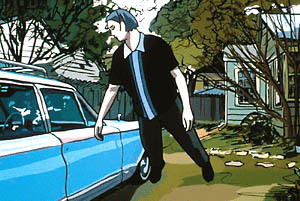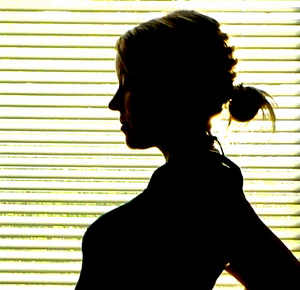Often, we can find that it is not simply the point of a message that can make an impression, but rather the style and manner in which it is delivered. Every day of our lives we are bombarded with an array of messages and directions, from proper ways to live, to what detergent would best clean our dishes. Considering the large amount of messages which are played out every day, it is only natural that some look towards their dreams to escape. It is even possible that we can have trouble differentiating between our dreams and reality. With that in mind, an excellent film on the subject on what exactly life and dreams are, and the difference, if any, between them, is Waking Life. Although the film may not be the easiest to follow, by absorbing and understanding the ideas within it, perhaps much can be gained towards even understanding the life that we live every day.
However, like any lesson or message, we must first understand Waking Life, in order to gain the full effect of the messages within it. In the opening scenes of the film, we see the main character, who forever remains nameless to the viewer, dropped off at a random location and subsequently struck by a vehicle. However, despite the initial reaction that he has been dreaming the event, we quickly come to realize that perhaps his accident was the reality and the rest that follows is simply a long and lucid dream. It is not a far stretch to say that the entire course of the movie represents an altered state of mind. The question though, lies in what exactly that altered state is, and how we can hope to use it to understand the rest of the movie. If we look in the literal sense, it seems that the main character’s altered state is one of perhaps a coma, or near death atmosphere.
In fact, one of the views expressed in the movie is that before death, the brain has a remaining six to twelve minutes of function remaining. With that in mind, it seems that the movie plays out in the main characters six to twelve minutes of last thought. At first glance, it would seem that the movie is too short to represent that time in the scale of how long dreams take and the amount of time that it takes them to come to fruition. However, we must also remember that throughout the character’s dream, we are not given a real sense of time, and the events and conversations that play out could actually represent a very long and involved period. So, although there are many other aspects of the movie that are open to wide interpretation, it is a subject of mostly agreement that we can say this his altered state, is, first, a dream, becoming lucid in the last half, and one of death or near death significance that he has been put into.
As mentioned before, although the ideas that are expressed in Waking Life are not unique to the picture, and are actually the views of various philosophers and different religions and perspectives, it is the style and way that these messages are delivered which gives them the powerful emphasis that they come to have. At various points throughout the movie, it can easily be seen how the cartoon style, also known as “rotoshop”, allows Linklater to further play with the distinction between dreams and reality. Perhaps some of the more entertaining examples of this can be found at various conversations throughout the movie. The characters conversation with the elderly man in glasses for example, where images pop into the background and swirl around the speaker’s head and hands are one example.
Also, during the movie shown in the film, “The Holy Moment”, at the end of the movie sequence, having failed to specifically witness the “holy moment in question”, the two characters involved in conversation turn into clouds and blow away into nothing. Another powerful example of this style comes with the depiction of both the angry prisoner and the man who is making his speech while driving. Both of these characters are depicted as being entirely red, mostly in part due to their anger and their rage. Although these depictions and effects could have been done if the frames in the movie were not painted over, the cartoon style of the movie brings the dream-like atmosphere into focus and paints an entirely different picture of the movie, adding, in a strange sense, an element of realism to the dreamy scenes.
In fact, the style of movie becomes so obscure, however, that at points it becomes impossible to differentiate between what is being awake and what is dreaming for the main character. In fact, perhaps some of the most powerful scenes in the movie occur before the character again “awakens”. Although it would seem that the main character wakes up several points during the film, there is no point in time during the sequence of the film, besides the opening few minutes when he is actually awake and living in the waking world. Rather, the sequences of him waking up, only to later discover that he is stll dreaming serve several important functions during the movie.
Firstly, the scenes act as a transition between some of the most central ideas of the plot. Secondary, it seems that the main character awakens every time he is exposed to an idea or action which is either shocking or central to the plot. Perhaps the waking up really represents the character’s attempts to understand and break apart the information that he is experiencing while he prepares for death. Rather then being awake in a literal sense, it is very possible that the sequences of waking up really represent a sort of new mental awakening at several points in the film for the main character. Interestingly enough, it is only in the last half of the film that he comes to be involved in his own dream, for the rest of the film he acts far more as a passive observer.
Of course, the entire movie brings about the question of what exactly sets dreaming apart from normal life, especially lucid dreaming. As the main character describes in Waking Life, “but this isn’t like any dream I’ve ever had before, it’s like it’s the dream”. And, in fact, if one really looks at it, the similarities between lucid dreaming and reality can sometimes have extremely blurred lines. It has even been said that one of the best ways to facilitate lucid dreaming is to occasionally ask ourselves, as we go about every day life, if we are dreaming or awake at the present moment in time. Lucid dreaming is similar to every day life in that we can control what is going on around us. In fact, even some schools of Buddhism teach that through lucid dreaming we can attempt to gain a better understanding of our lives and better organize our thoughts and experiences during waking life.
However, perhaps one of the most important things that can be gained from Waking Life is an interpretation into our own psyche. We have to ask ourselves, “are there some kinds of experiences that are more important, more real, and more significant in our lives?” Of course, each individual person will have a different conception of what exactly matters to them, and what is important. Depending on one’s current situation in life and what they are planning or feeling at the moment experiences can take on entirely different meanings. In the line of thought present in Waking Life, it is entirely possible that experiences in dreams can be just as powerful as experiences in normal life. This is largely dependent on where the personal and ideological boundaries of a person lie. The difference between inside thought and outside experience is, at best, sometimes a marginally separable idea. This is also very dependant on the time period in question. For example, in the past, it is likely that experiences or hallucinations were thought to be powerful signs from the Gods. Now, however, we put far less influence on hallucinations or dreams involving a greater power.
Although the technique used in Waking Life was not a new one, it was certainly a powerful choice for the movie. The messages and ideas contained within Waking Life are unique and influential. We can truly gain so much from our dreams and the altered states of mind which comprise our every day lives.






